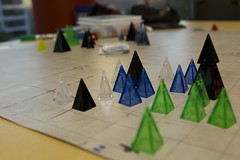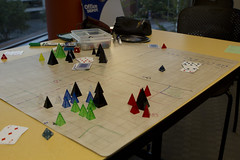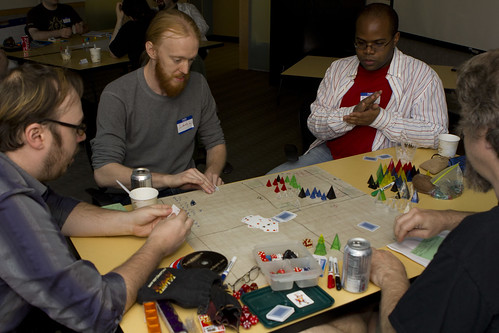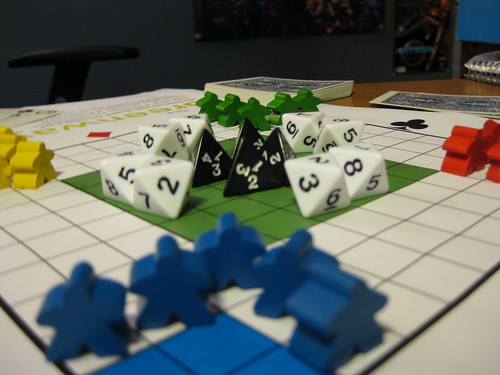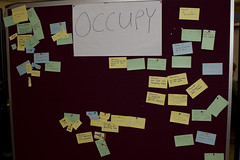 I was happy to host the second Cardboard Jam at the GAMBIT Game Lab with Darren Torpey of Boston Game Jams (and Boston Indies and countless other Boston game development groups). Sixteen local developers, researchers, and students joined us for two days of rapid iteration of board, dice, and card games. After a few hours of brainstorming and pitching ideas to the group, we coalesced into five teams and spent the remaining 20 hours creating games. By day one's dinner time, we were trading people around to test all of the games. All five games were finished and playtested by the end of the game jam, with rules and pieces that could be picked up and played by others.
I was happy to host the second Cardboard Jam at the GAMBIT Game Lab with Darren Torpey of Boston Game Jams (and Boston Indies and countless other Boston game development groups). Sixteen local developers, researchers, and students joined us for two days of rapid iteration of board, dice, and card games. After a few hours of brainstorming and pitching ideas to the group, we coalesced into five teams and spent the remaining 20 hours creating games. By day one's dinner time, we were trading people around to test all of the games. All five games were finished and playtested by the end of the game jam, with rules and pieces that could be picked up and played by others.
OCCUPY
The theme of our game jam was Occupy. I emailed Darren the week before the game jam started and pitched the theme to him - I've been keeping up with the Occupy events around the nation, especially OccupyWallStreet and OccupyBoston. He liked it and so it was then presented to the jammers at the start of the brainstorming session. They came up with dozens of ideas; some pitched mechanics for which 'occupy' was a good fit and others pitched fictions and themes based on the word. Having a verb as our theme was useful in that all of our pitches seemed to gel well with the theme.
We grouped the pitches by shared aspects and from there the jammers formed into teams. My team of four chose to explore a two mechanics: Conway's game of life and RoboRally-style programmed moves with cards. We placed these two pitches next a few other cards that were similar and got to work. One of these related cards was a pitch I came up with, where the players could be groundskeepers at a park during OccupyWallStreet and the NPC actors as police and protesters. I never mentioned this theme again to the team, but I think it was in the back of my mind throughout the event.
Making the Game
The game we created on the first day was a four-player competitive game, where each player could move 5 pieces in a manner similar to Conway's Game of Life's birth and death rules, in order to reach pieces in the middle of the board to then push them to the player's own corner before the other players could do the same. The pieces in the middle were controlled by cards played from by the players. This game grew as 'Ants & Aphids' - there was a swarming feel to the movement of the player's pieces which seemed insect like. Whenever we made a change, I kept asking the team (probably to their annoyance) "what are our values?" and "what do we want to see in the gameplay?" At the time we wanted to encourage competition between the players, reduce the randomness of play, and maintain the insect-like feel of the player's pieces. We experimented with having a wrangler or rancher who kept the aphid in the pen. We tried a few different win conditions, including requiring two aphids in the pen (out of 5 or 8 available) but settled on requiring one aphid (of 4 available) moved into a player's pen, and kept in the pen for a full round.
After playtesting with 3 different teams, we added a new element to the game; obstacles. At first the obstacles were static, designed to counteract with mechanics that allowed each player to move quickly across the board, a 12x12 grid. We tried a few placements for the obstacles but then realized that we could have them move at each turn as to constantly keep the field of play changing. Once this happened, the true nature of the game started to emerge. These obstacles, tall yellow pyramids, became Police figures. They surrounded the central pieces in the beginning, trapping them within the center of the board, and our players would have to rush in and push the center pieces out. So we switched the game's fiction from insects to people - the center pieces were "Protesters", friends of the players who were about to get maced by the Police figures surrounding them. We were individual groups of friends trying to save one of our buddies. But why did we only want one? I was discomforted by the gameplay - there was something wrong. The game was the same as we had before but the feel was not right. By the end of the Jam we decided that the players were rival news organizations, whose goal was to pull a "Protester" into our camera van and get their story out before our rivals did. We shipped the game as 'Get the Scoop' and demonstrated it to our fellow jammers. We were finished with the game but I still wasn't quite satisfied with the result.
The Next Morning
 Monday morning at 1pm, I was still awake, watching the Boston Police Department (and later I learned, other forces, including the Massachusetts State Police) raid the second OccupyBoston camp and arrest the inhabitants. I wasn't there with them - I was watching via a live camera at the top of a building, looking down at this patch of green, surrounded on four sides by people (who I later learned to be volunteers from Veterans for Peace) and various police and EMT trucks and vehicles. My game was being played in real time, the rules were similar but the pieces were different.
Monday morning at 1pm, I was still awake, watching the Boston Police Department (and later I learned, other forces, including the Massachusetts State Police) raid the second OccupyBoston camp and arrest the inhabitants. I wasn't there with them - I was watching via a live camera at the top of a building, looking down at this patch of green, surrounded on four sides by people (who I later learned to be volunteers from Veterans for Peace) and various police and EMT trucks and vehicles. My game was being played in real time, the rules were similar but the pieces were different.
The next morning (after a few hours of sleep) I looked at the game my team made, made a copy of it to a new document, and changed the names of the pieces. The Police Officers were now Veterans. The Protesters became Occupiers, and the Journalists became Protectors. Each player now controls a squad of Protectors who are charged with removing the Occupiers from the Greenway, a 6x6 square in the center of the board. The Protectors can use their 'words' (the cards the players have) or force (by pushing the Occupiers off the green and into the vans on the corners. The Veterans are doing the best they can to protect the Occupiers. The Protectors are all different factions, so they are still competing against each other. The goal is the same as before - it isn't to grab absolutely everyone, just to fill your van with one Occupier.
Looking back at this process, it is no surprise that the game became this way. It was always about control - taking something that didn't want to be taken and controlling its movement. Of course my occupy game was going to be about police actions. One issue I had during the game jam was that I didn't want to make a game that I couldn't stand by - if the game was going to have a message, I wanted it to be meaningful and thoughtful. Working on a team with other people that I never met before, I knew that this might not be possible, so I avoided anything controversial. I also knew that I didn't have a clear viewpoint of my own yet about the Occupy movement, so without having something to say I kept my mouth shut. But because of this live video feed and the action of changing the names of the pieces in the game, I felt more connected with the events and that I could say something about these events through making the game.
Because of my work on this game, I think I've finally conceptualized an aspect of game design that I thought I understood intellectually, but only with experience have really grasped it. Games make themselves. We birthed the game by first choosing a few mechanics and sticking them together. The game was made by playing the game over and over again. Which each playthrough, the game morphed into something it wouldn't be if we just wrote a bunch of rules, tried it once and called it a day. It's not that games are ever made without testing, but I wonder if sometimes designers don't listen to what the game wants to be. Or if that's a bit vague and anthropomorphic, they don't play with their game. Engaging with the game at its own level - playing with the rules over and over again, rather than over thinking each possible change that could be made - revealed the changes that needed to be made to make the game stronger and better. After each play through, we were able to cut and shape the mechanics and rules, to better support each other and to bring out the true theme of the game.
Control
Our game wasn't just about control, it wanted to be about control. The verb 'occupy' was aggressive and the first two mechanic choices we made were competitive and served cross purposes. If two people programmed the same piece and did not agree on the order, the order of the moves would then be random - control was lost. Because the game was about control, it needed a fiction that would support it well. It couldn't be a nice game - pushing living beings around is not a nice thing to do. When I got home after the first day of the jam, I read up on how honey ants herd aphids. They step on them and tear off their wings so they won't fly away.
I'm not a researcher, but through my work with researchers like Doris Rusch, Jason Begy, Matthew Weise, and others in my lab, I have developed a better understanding about how players interpret and play games, how metaphor is important in linking concepts to mechanics, and how a basic set of verbs creates the story of the game (and yes, boardgames have stories!). It's in my second nature now to think of real world events in the language of games, and to make games in order to better understand these events (or at least my feelings about them). I am still unclear about if what I've made is a good expression of what I understand about the OccupyBoston arrests. I am curious what players of this new game think my intention was - or if there is a message. If you'd like to play the game, I'm actively working on it and the rules are publicly available. Compare it to the game we made as a full team. Are the differences important? Is one more fun than the other? Let me know what you think here, via my website, or on twitter.
Thanks to Michael Carriere from BostonIndies for the photos of the Jam!







